Broader e-bike thoughts
I clambered aboard the e-bike again today, after finally reinstalling the motor on the Jones LWB HD/e(lectric) during the week. As tends to happen every time I ride an e-bike, I’m overcome once more with evangelical-like passion and enthusiasm for the role they could play in changing city mobility, if given the chance (I read today that in 2021, 52% of car journeys in the US were less than 3 miles).
Once you’ve spent some time with an e-bike, the question becomes less “why would you get one?” as more “why wouldn’t you get one?”
If you’re a car owner, e-bikes make a compelling case to drive less. They’re both an efficient use of your time, especially on longer journeys, and they’re fun! And if you already cycle, they level the playing field and make life so much easier in car-centric areas – which, let’s face it, is an awful lot of the world.

The LWB HD/e without the Bafang motor.
I’m currently preparing a review of the Jones LWB HD/e for Bikepacking.com.
Unusually, this is a bike that’s available in both standard or e-assisted form. The transformation comes by way of a 750W Bafang BBDHD mid-drive kit, though there are also various design features that make the donor frameset (the Jones LWB HD/e) particular e-bike suitable, like a wheelbase that’s substantially longer and a tubeset that’s intentionally stiffer than the standard LWB (hence HD/e: Heavy Duty/Electric). There are other mods too, like the choice of parts, which are intended to be robust enough for the extra torque generated by the motor. For example, its cassette is steel, it uses a single-click shifter, and it’s specced with 36-hole, heavy-duty rims, all of which are more e-bike friendly.
My review will be focused on the Jones LWB HD/e in its pedal-power guise (unfortunately, e-bikes remain too divisive a topic for bikepackers to handle in the US) but I’m not ashamed to say that I’ve enjoyed it equally in both its forms, and have swapped between the two on a few occasions.
If you have all the tools at the ready, the conversion from muscle and sinew form to e-assist takes 1-1.5 hours, depending on how many times you’ve done it, and mechanically adept you are.
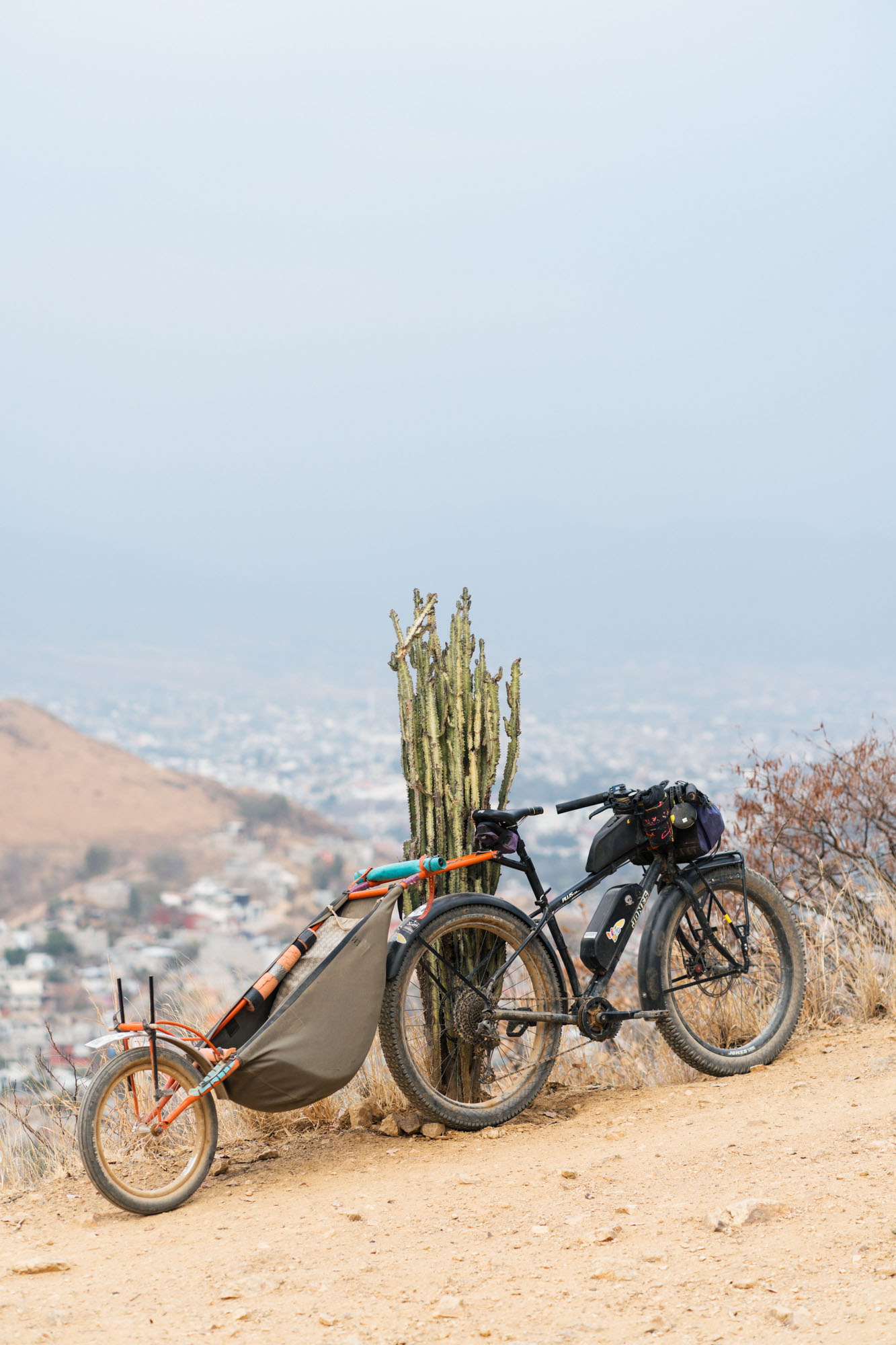


Most of my e-bike rides involve hauling cargo – Huesos, a 18kg payload – pulled in a Frances Cycles Farfarer. In terms of electric assist, the display that I’m running on the LWB HD/e has 5 levels to choose from. I tend to ride in levels 2-3, as I find it strikes a good balance between lending a helping hand on climbs or keeping up with traffic, and still feeling like I’m pumping blood around my body. On the odd occasion where I need to dash about, level 5 is fun too though!
One of my local loops involves a stout climb up to what we call the Microondas – a hilltop marked with a series of antennas. Unless I leave home by 6.30am, the early morning traffic during the week is becoming ever more unpleasant. There’s also a particularly steep climb past the hospital that’s a real lung burner, especially if you’re stuck behind a car. Because the e-bike does such a wonderful job at editing down this less appealing part of our morning ritual, it motivates me to get out more, knowing the two of us can access the trails more quickly and enjoyably. On the days I ride my lighter, non-assisted Jones, I’ll often use the e-bike to get up there at the end of the day and enjoy the sunset.

Every time I ride an e-bike (especially with cargo) the same excited thought pops into my brain: what if even half the people who’d normally drive in the city rode an e-bike instead? Think of all the space it would create. And how much more enjoyable city mobility would be.

E-bikes continue to be very divisive for some, so I don’t want to become defensive about why I enjoy riding one, or list a string of reasons as to why I think they’ve such a great compliment to non-assisted bikes.
But broadly speaking, I’m convinced e-bikes can be transformative for many city dwellers, and ultimately they can play an important role in reclaiming our towns back from cars and trucks, making them more liveable again. Speaking personally, I’m becoming increasingly frustrated with city traffic and localised pollution. Daily, I can’t help but imagine how much roomier and more relaxing Oaxaca would feel without the footprint of so many cars, SUVs, and trucks on its streets (all of which are getting bigger and bigger every year), parked or otherwise. This video from Not Just Bikes is especially sobering.
As for bike touring, I’ve enjoyed two great e-bike trips with my mum, one of which you can read about here, as well as a local overnighter on this very bike to Hierve El Agua, a 65km ride away.
All of this inspired me to jot down a list of aspects that I particularly like about the Jones LWB HD/e and the mid-drive Bafang BBSHD (rather than the more generic pros and cons of e-bikes) and the elements that I’m less enthusiastic about.
Aspects I like about the Bafang (and the LWB HD/e)
- The very same steel bike, in twenty years’ time, will likely still be in service, even if it’s without its original motor. (Hopefully, the motor should be good for 10 years+)
- The Jones Geo is a winner for me. The front end is light and engaging, and the riding position is supremely comfortable.
- It’s a really well-considered bike too – there’s a 36-hole wheelset, overbuilt hubs, a long lasting, steel cassette, and powerful brakes. There’s also a choice build kits, so you can get the exact bike you want.
- It’s kind of 2 bikes in one. E-commuting during the year and non-e-touring in the holidays? With some practice and the right tools to hand, it takes about an hour or two to make the changeover, so while it’s not something you’d do on a weekly basis, it’s straightforward enough for a few changes each year.
- As it’s a kit, the battery and motor are less likely to become obsolete, compared to fully integrated systems. If need be, you can even change motors, as the frameset should be able to accommodate any mid-drive kit. You could also defer the cost of the bike by buying it non-assisted initially, then fitting your chosen kit yourself.
- I love the way the HD/e rides with e-assist. With the extra weight, the low centre of gravity, and its stiff frameset, it’s unwavering under loads. In e-bike mode, it’s peppy like a motorbike but without the noise and much less of the high-speed dangers. Simply put: it’s SUCH FUN getting around town! How often do you say that when you drive a car in the city?!
- Due to the high weight and low centre of gravity, there’s lots of stability when pulling the trailer, with 18kg of Huesos and paraphernalia.
- I don’t know what it is about these moto-style Bafang brake levers, but they feel great, and allied with Avid BB7s, there’s ample stopping power.
- 29+ tyres are really good on dirt roads and potholed paved roads alike, and for general riding confidence. The fact that they’re heavy is much less of an issue than it would otherwise be, as there’s a motor to help you out.
- Bafang BBSHD offers ample power to get you up to speed quickly: 160 Nm of torque! Mine is adjusted to 28mph (making it a class 3 e-bike, in terms of US laws). In terms of real-world riding, I can climb a steep road easily on level 5, keeping up with cars. And Level 3 is plenty for general use. This power and speed mean there’s less speed differential when I’m sharing the road with larger vehicles. And whilst I don’t think it’s necessarily needed in cities with good bike infrastructure, courteous drivers, or less pollution, it feels really welcome in places where car drivers can be overly assertive and aggressive. I can hold my own in the flow of traffic, rather than fighting like a minnow for survival within it!
- Being a long-established motor and kit, it’s easy to find parts and batteries online. I’ve read that the BBSHD is a very reliable motor.
- The system is pretty quiet.
- Jones mudguards great! They help keep everything protected from crud.
The Cons
- It’s a bolt-on kit, so there’s a tangle of wires to zip tie out of harm’s way. I like the way this bike looks, in a Mad Max kind of way, but it’s not aesthetically neat and integrated like the latest wave of dedicated e-bikes, and won’t appeal to everyone.
- The whole bike, in e-bike form, is expensive, particularly for a ‘kit e-bike’. It might be better value to buy the complete bike or frame and fork, then add the kit yourself, especially if you’re tech savvy.
- The Bafang BBSHD is a cadence-activated system. This means that at slower pedalling cadences, there can be slight delay to the motor kicking in or turning off. Depending on your power level, this can result in a jerky feel that can be offputting at slowers speeds – particularly on steep, loose climbs. If you choose a power setting that’s too high, it can feel like the bike may run away with you, as it’s based on your pedalling cadence, and not the torque you’re putting through the pedals. I generally aim for a lower assist level, so I’m not ‘ghost pedalling’, but I’d prefer more natural, torque-assisted help that feels more ‘bike-like’.
- Most of the time, Level 2 or 3 is sufficient. But if you’re clipping along at one of the higher power levels and need to slow down quickly – say, you hit a traffic light, or in the case of Mexico, one of the innumerable ‘topes’, you need to remember to decrease the power and change my gearing. It takes some practice to hone this new style of riding.
- Personally, I don’t find the Bafang lends itself well to techy singletrack, at least without learning a new riding technique, as above. (Without the motor, however, I actually find this frameset much more capable than I was expecting on trails – the steering is quick and the big tyres roll over everything, even if the wheelbase is extra long and the bottom bracket is low).
- A 12-speed drivetrain feels unnecessary on an e-bike, given that the motor makes up for larger jumps in a cassette. I think an 8 or 9-speed system would be ample. Perhaps the new Shimano Cues drivetrain would be a good option, or the Box Four 8 system? I even like the idea of a continuously variable transmission like the Enviolo, as any loss in efficiency is made for by the motor. An internally geared hub, like the Rohloff, could also be great, for changing a handful of gears at a time.
- The whole setup – bike and kit – is heavy. This makes it unwieldy to move around, especially in a small apartment, or up a flight of stairs.
- The Q factor (distance between cranks) is wide. This feels like less of an issue on an e-bike but it may bother some. Upside: better clearance between the chain and a 29 x 3.25 in tyre.
- No Bafang App. The Bafang BSHD requires a certain amount of knowhow and a peripheral device to customise. Unlike many e-bikes on the market, there isn’t an App to adjust the amount of assistance in each power level. Personally, I’d like to increase the power output of level 1 and decrease it slightly on Level 3. Similarly, Apps can immobilize the motor when the bike is locked up.
- My Bafang display is also very basic – just 5 power levels, speed, and an odometer. It would be useful to have one that suggests an approximate idea of how many miles I have left in the battery, based on data collected during a ride, or the power level I’m currently in. Bafang does have a bunch of displays available though, it’s just hard to figure out what’s what.
- I have a 48V 17aH battery, and it takes a long time to charge – perhaps 6-9 hours. This is fine for city riding, but it does add some logistical challenges on a weekend campout.
- It would be nice to have a powerful front light wired in too.
- No eyelets below the downtube of the frame, for extra water-carrying capacity.
And some questions I need to answer
- How reliable are the batteries, long-term? I need to look into this, with regard to charging/life cycles, and what happens if they fail. From what I understand, slow charging is better for eeking out battery life.
- How best to dispose of large lithium batteries at the end of their life cycle? I believe that with care, it should be possible to get 4+ years out of them.
- How serviceable and repairable is the Bafang BBSHD, compared to a more conventional brand like Bosch or Shimano? Is there any technical support if things go wrong? Because it’s a kit motor, it’s a bit of a minefield figuring it all out.
Any alternatives to the Bafang?
- There are other mid-drive kits available, but the one that interests me most is the CYC Photon. From what I’ve read, it’s amply powerful and there’s an accompanying app too. Best of all, it’s torque activated, which I think I’d really like. It’s also very compact in size. Presumably, I could use the same battery, brakes, and wiring that I already have.
On the divisive subject of throttles
- I currently run a throttle, although I don’t use it much when I’m riding. Mostly, it’s to get going quickly at traffic lights and beat the surrounding traffic, especially if forgot to gear down when I stopped. It’s also useful when need a quick turn of speed if a bus is breathing down my neck, and in Level 1, I also use it to help me get the bike and trailer up the flight of stairs to where I live. Because it’s a thumb-activated, plasticky throttle, it doesn’t have the feel and resistance of a moped or motorbike throttle. To be honest, I think I’d get bored if I used the throttle alone! But in conjunction with pedal-assisted riding, I find it very useful.
The Bafang in Muck and Rain
- Lastly, the LWB HD/e during the rainy season, before I fit full-length mudguards. The electronics have so far proved reliable in some heavy downpours. Although the kit is very exposed to mud and muck, there’s been no ingress from what I can see. The electronics did get glitchy once after a storm, and I’m not sure if that was user error in some way, as it was an isolated incident. Full-length mudguards, as are fitted now, should help with long-term durability.

OTHER E-BIKE THOUGHTS
This isn’t especially related to this bike, but I liked GCN’s 8 Things I Wish I Knew before Getting an E-Cargo Bike.
And some 20in city e-bikes that are on my radar:
The it comes to e-bike and integration, it’s hard to imagine anything more beautiful than the LeMond Prolog and Dutch.
My long-term plan is to convert my Surly Big Fat Dummy into e-assist, though of course Surly does some pretty cool e-bikes too now, like the Big Easy and the Skidloader.
The Swytch looks like a cool conversation kit too, especially for commuting on city bikes or vintage mtbs.
Incidentally, Jones made a couple of prototype ti LWBs with torque-activated Bosch motors, which looked really cool too. I can’t track down a link right now but I’d love to try one!
A recent e-bike ride into the hills that got my thinking about an e-bike tour!

Although I can’t imagine a time when an e-bike would completely replace a non-assisted bike for me, Friday’s ride with Dhurba and Huesos, did get me rthinking about how much I value having access to one. Not only was it hot, but the traffic frenzy both leaving and re-entering town felt especially overwhelming; I suspect I’d have been sweaty and miserable had I been towing Huesos via leg power alone.
In fact, I had so much fun with the e-bike that I even started to imagine a trip to the coast with it, and the challenges and logistics of doing so (ie keeping the battery charged). Bear in mind that I don’t ‘train’ (say, climbing for the sake of climbing), and whilst I’m drawn to the personal challenge and stoicism of touring on my own steam, I’d like to think that my riding is always tied with enjoyment (read, climbing for the sheer joy of climbing!)
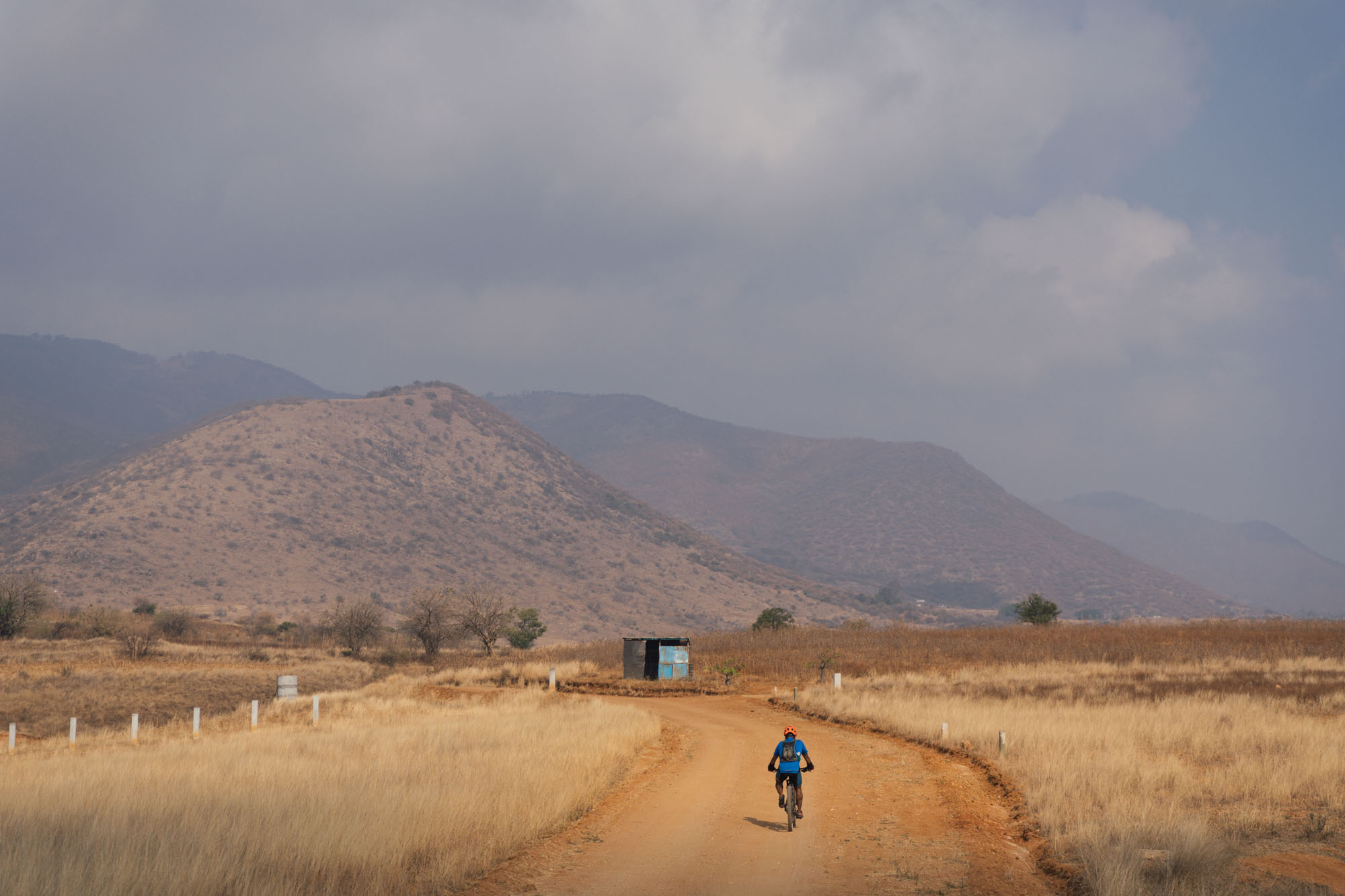
Heading up into the hills with Dhruba.

The temperature forecast dangling tongues.

Given how hot it was, it was nice to be able to give Huesos an extra lift when needed, even up a climb.
This little cut-through involved some steep and loose climbing, which requires a different riding technique with the Bafang.
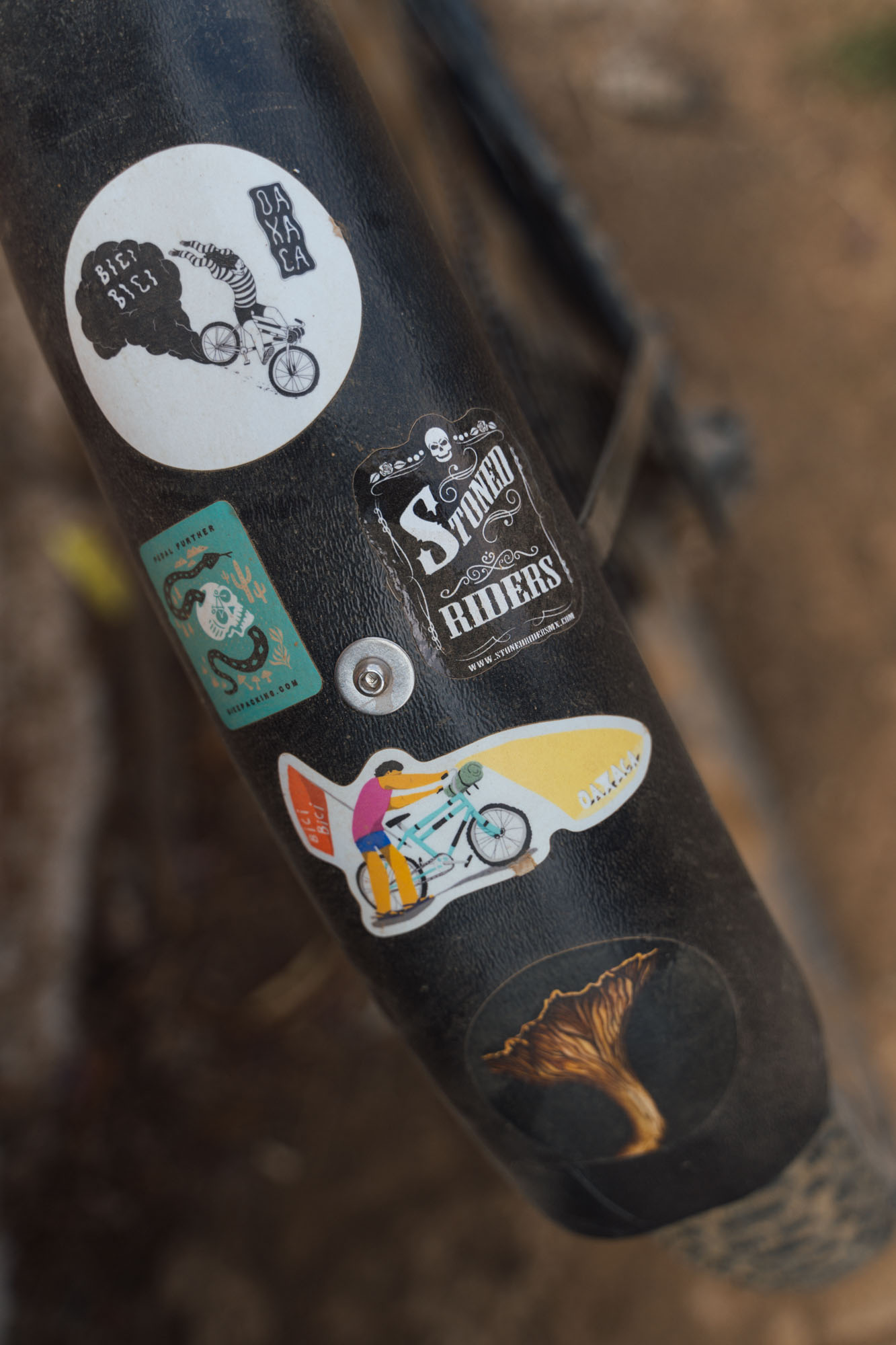
The sticker collection is strong! Both Emma’s chanterelle and Bici Bici Oaxaca are available to purchase (-:
Happy Dhruba with Cold Corona!

Huesos and his chariot caused quite a stir in Santa Ines del Monte. A lady with a chicken under her arm smiled at the doorway and ask hesitantly “Does he bite?”
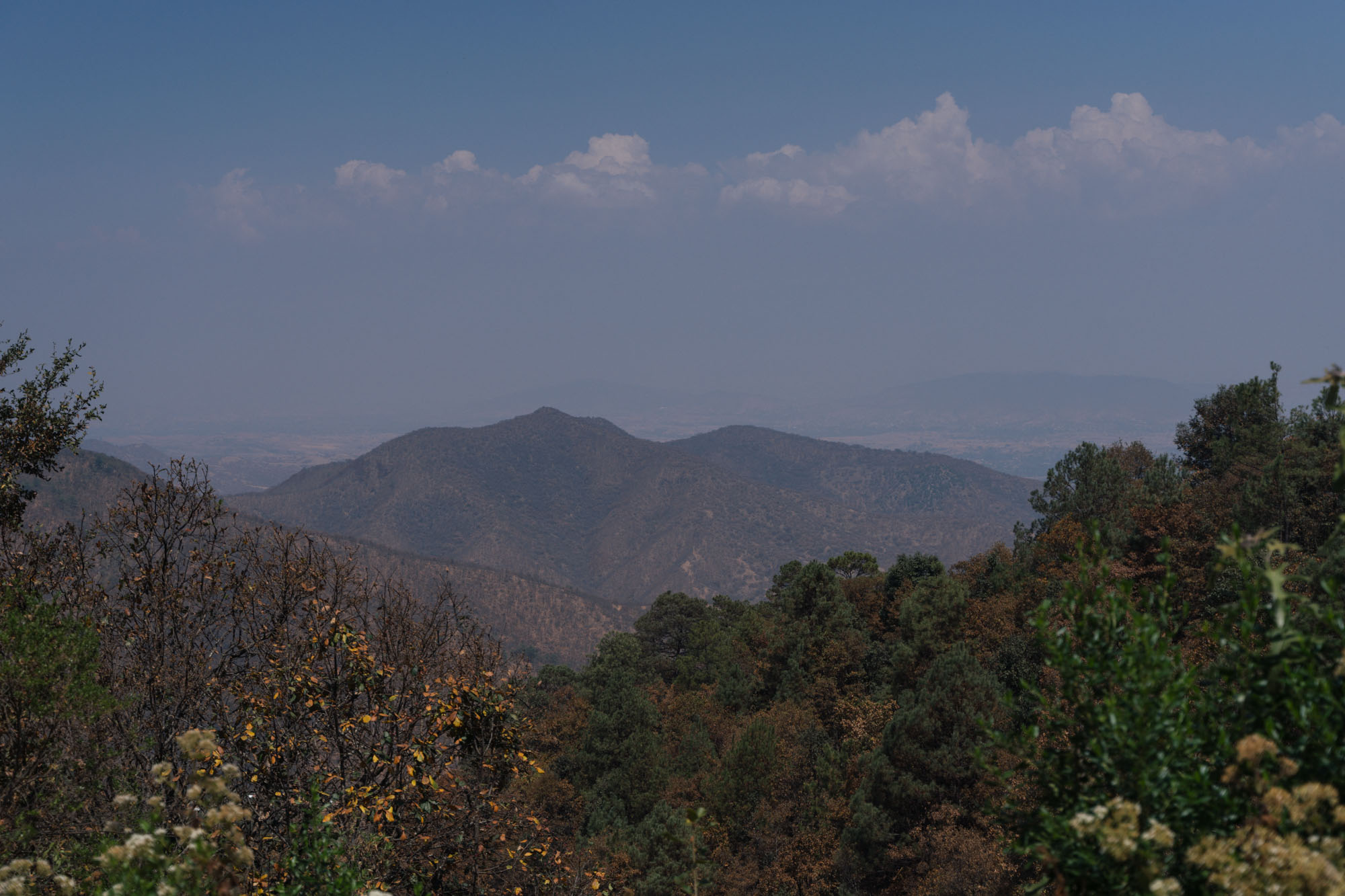
Heading back down the ‘hill’ again, into the comal of the valley floor. I turned the assist level to 0 to conserve battery life. The Jones’ 200mm rotors front and rear were welcome.
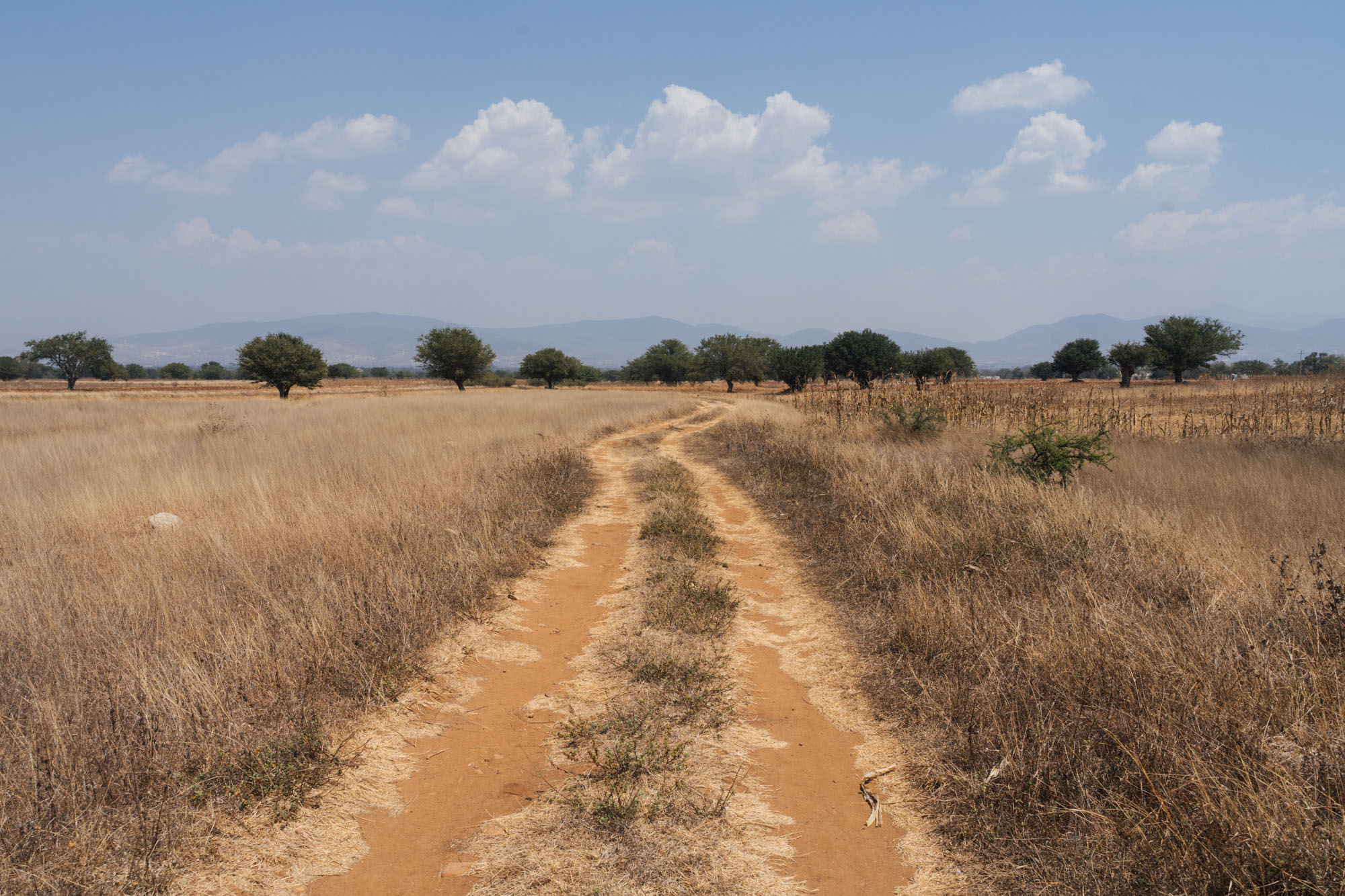
And back down into the valley again. These grassy, rural roads are such a pleasure to amble along and explore. It was then a 20km ride back into town from Dhruba’s house to mine, which is where having an e-bike was especially welcome.
THE ROUTE
Plus 20km to get back into the city. That’s where an e-bike really excels; getting across town in rush hour was so much more enjoyable than it would have been otherwise.
That’s all I can think of at the moment…
This blog sometimes acts as a notebook for me. It’s a useful and fun way of getting some initial thoughts and images down quickly, giving them a chance to grow into fuller and more rounded ones. If you have any feedback to offer, especially on the Bafang and its serviceability over a number of years, I’d love to hear from you.

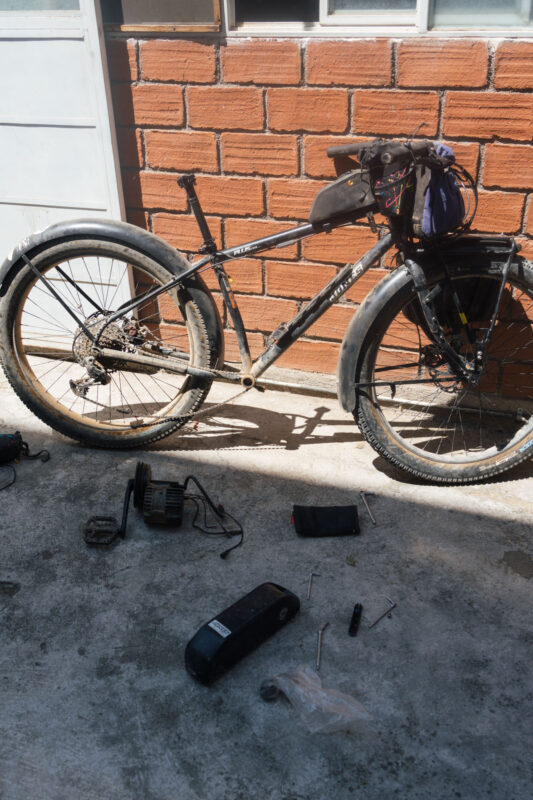


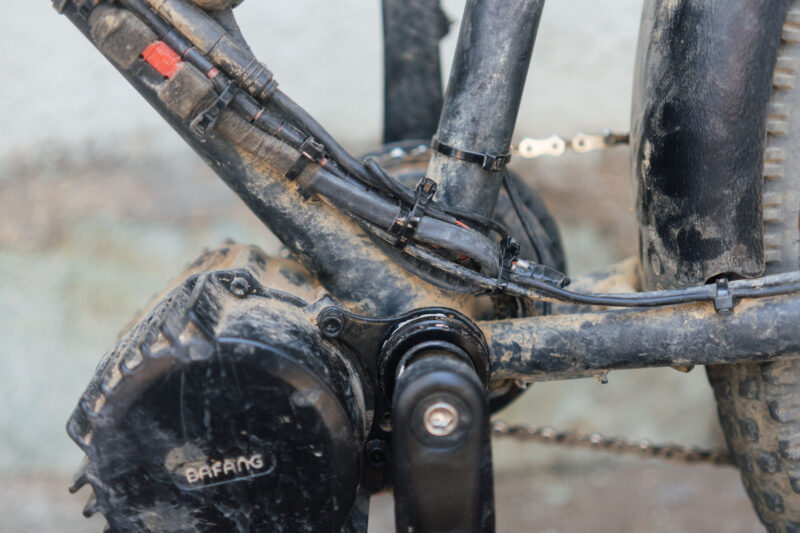
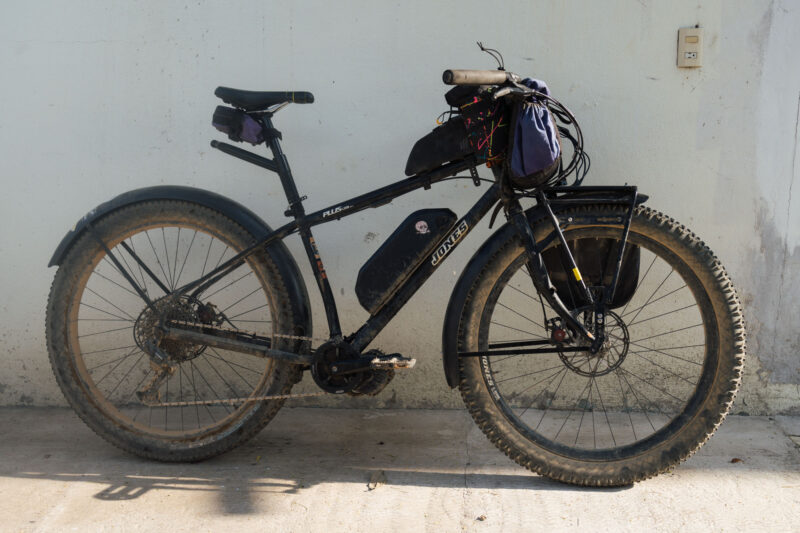








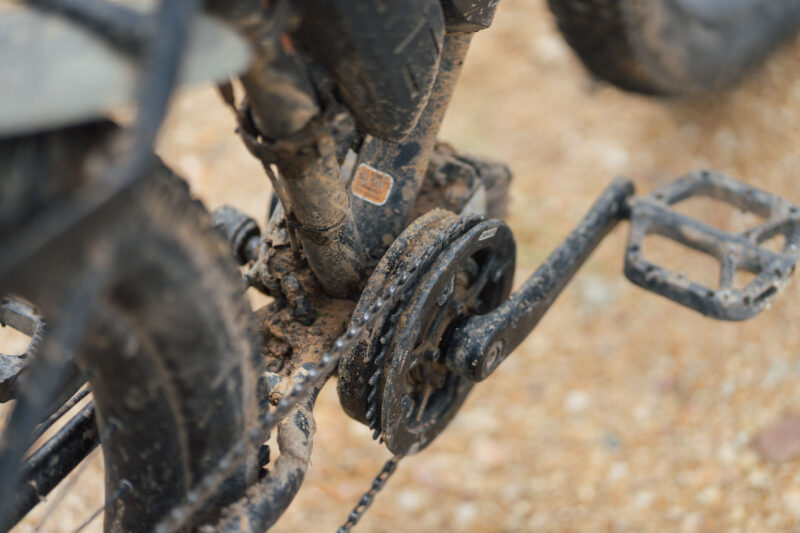

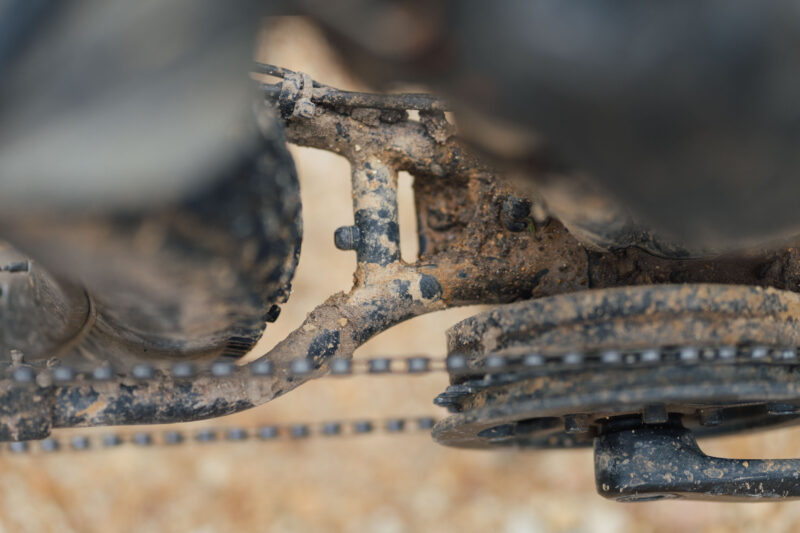
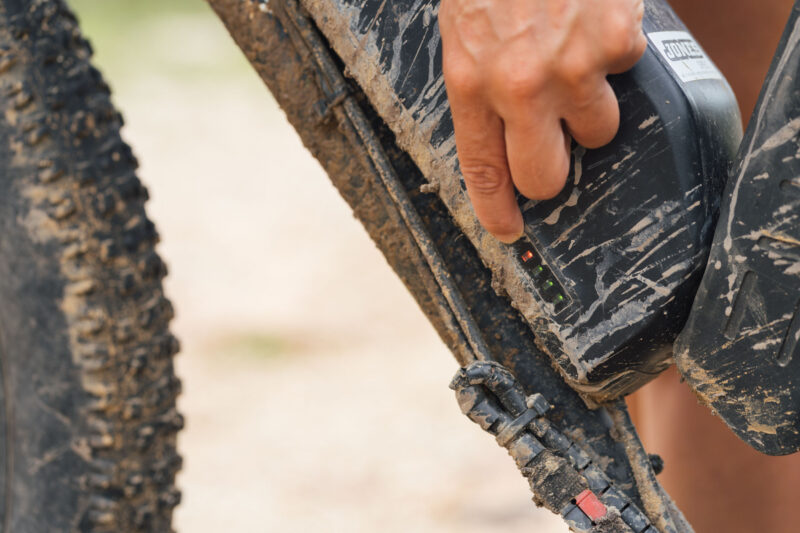
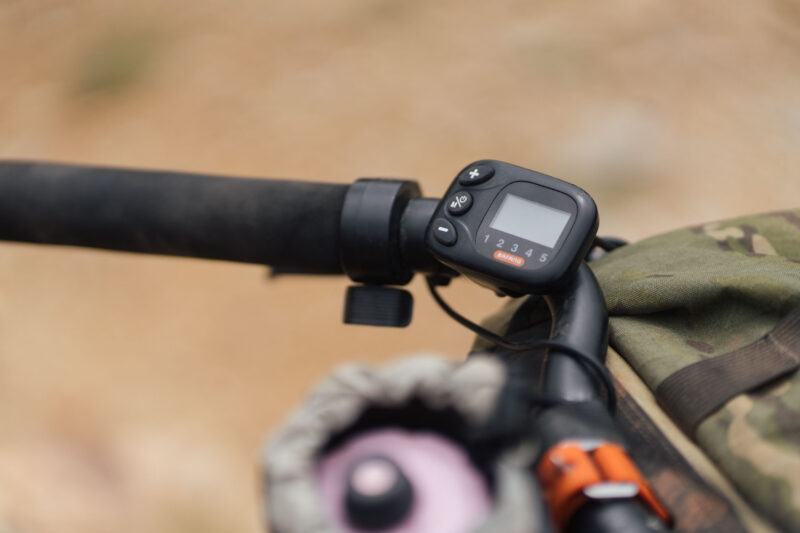





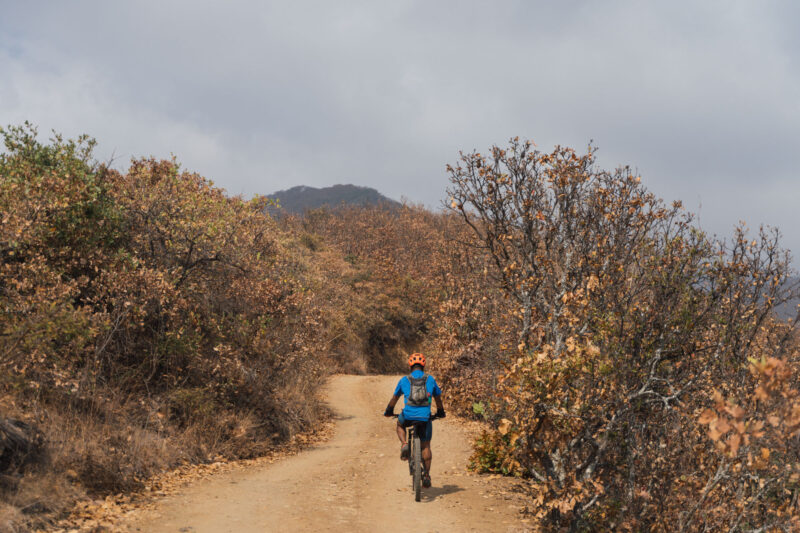
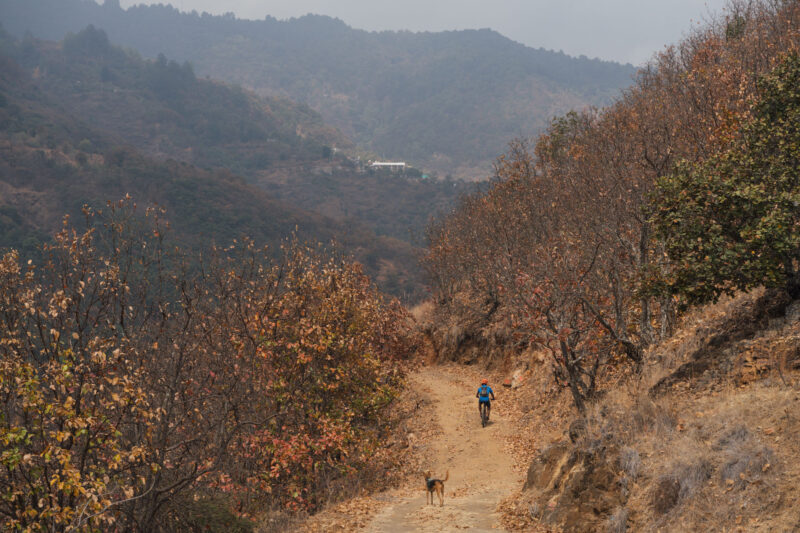
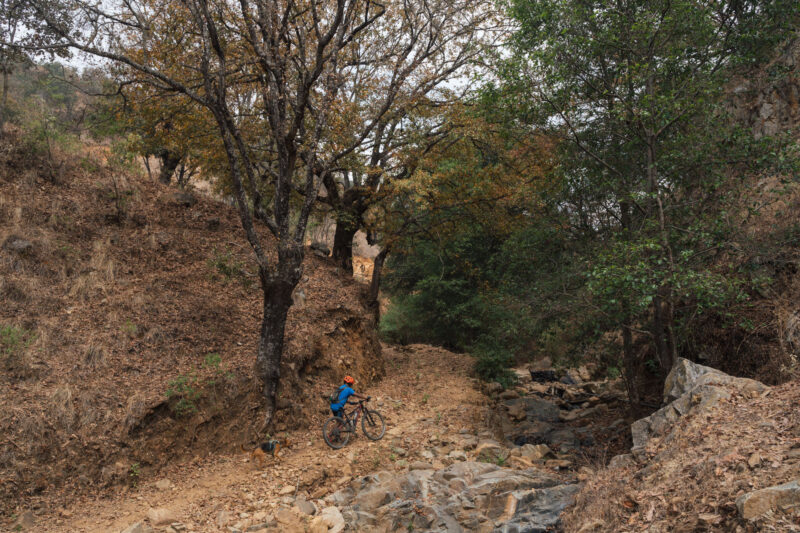
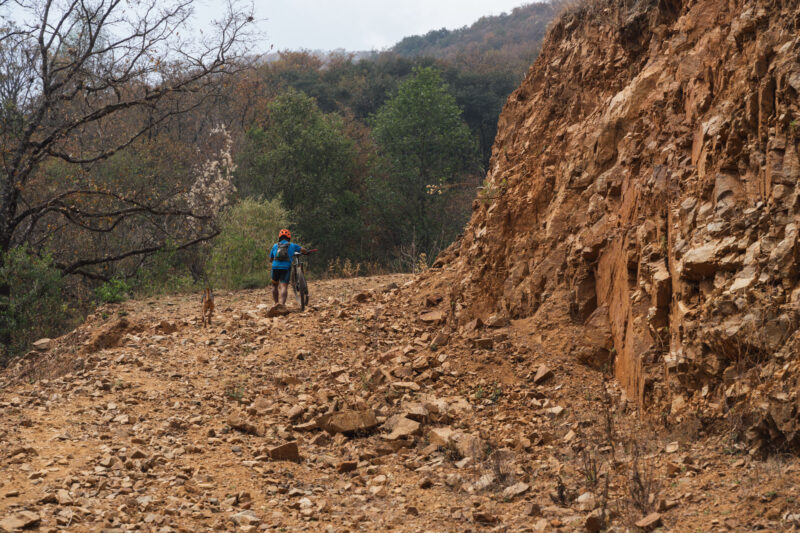
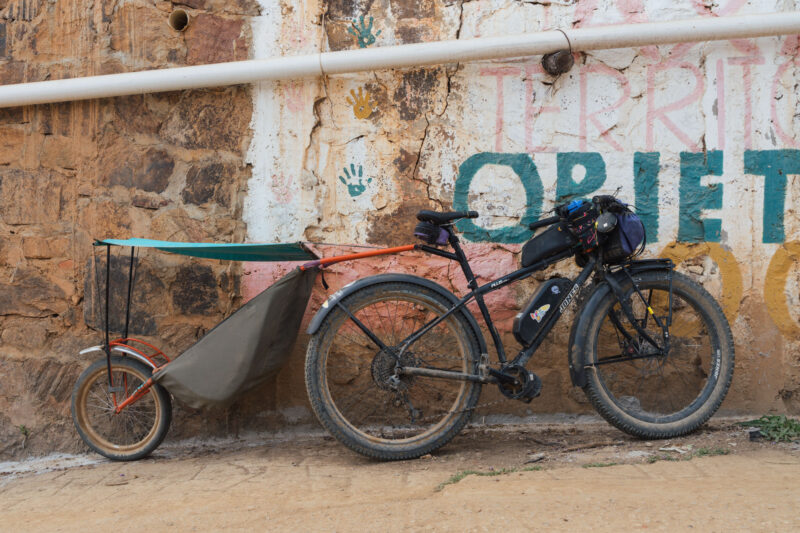




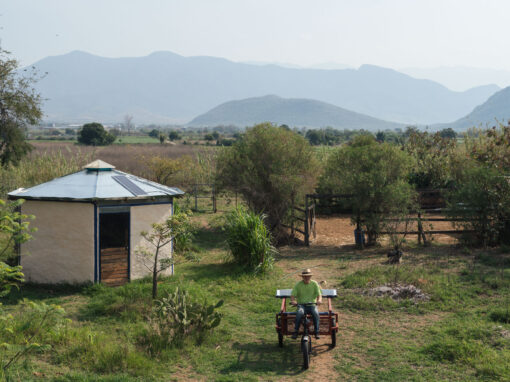

Joe
10 June 2023 at 10:59 pm
Great write-up Cass! When is that Bikepacking.com review of the non-assisted LWB HD/e going to come out?
I’m interested in that frameset in non-assisted mode as a dirt-touring bike. But I would occasionally ride trails with it, so I’m excited to hear thoughts on how it performs in that manner. I’d also be interested in getting just the HD/e frame, primarily for the long chainstays and all the perks of that, but then adding lighter 32h wheels and the lighter, regular LWB truss fork. I wonder how all that would mesh together.
Speaking of long-chainstays, you really ought to get your hands on a Rivendell Gus Boots Wilson and give us a report (560mm chainstay and 1315mm wheelbase! In size large, but I’ve heard it’s terrific on trails and doubletrack)
Cass
13 June 2023 at 3:41 pm
Hi Joe!
Is there a reason you prefer the idea of the LWB HD/e over the standard LWB? E-assist aside, the former is best suited for heavy loads – it tracks really well when fully laden – whilst the latter is more suited to trails, and comes in a bit lighter too. However, there’s a certain amount of overlap, and I think an HD/e with a lightweight wheelset is also fun on trails, albeit slightly milder ones. The extra-long wheelbase is super stable, yet it has the same front-end numbers which translates into similarly playful steering, which is one reason I like Jones LWB geometry so much. This said, the standard LWB also has a really stable ride compared to many other bikes, and I think it climbs techy terrain better – the rear wheel of the LWB HD/e is more likely to slip out, in my experience. Worth noting is that the LWB HD/e is a little harder to box for travel, just because it’s that much longer. But as a heavy-duty, super robust tourer, it’s awesome. It sounds like you are a fan of long wheel base bikes in general, and it’s certainly that!
I do hope/plan to get that write up of the non-assisted HD/e up on the site soon. I just need to grab some last photos, which I’ve done now.
I almost got my hands on a loaner Gus and I was really excited to try it, as I think it would be right up my street and a great bike to have on the site. But I think Riv were worried I’d compare it with a Jones (personally, I think it would be a fascinating comparison!), so had a change of heart. And, there was also some uncertainty over its future. Shame, as it looks like a cool bike!
Joe
20 June 2023 at 3:42 pm
Thanks for the reply Cass. Regarding a preference for the HD/e over the regular LWB… I don’t know, just typical American (and especially Montana, where I’m at) thinking! Long chainstays are good, so even longer must be better, right!?!
I’ve been admiring Rivendell for years, and their bikes just keep getting longer in the rear end. But personally I have a Yuba Mundo cargo bike (unassisted) with real swept back bars that put me upright. The comfort is unlike anything else I’ve ever ridden. So it just has me wondering how far you can take the long rear end to aid in comfort and stability, while still enjoying the ride on singletrack (and finding it capable there). It sounds like you did in fact notice a difference in trail-capabilities once the bike sized up to the HD/e. And Jeff Jones clearly did a lot of testing and landed on the regular LWB size to perform standard trail duties while still being stable in a loaded dirt-touring situation.
That is a shame you didn’t get to test Riv’s Gus Boots Wilson. Apparently they have a new trail-ish bike coming out in the Fall.
Take care!
Fernando
21 June 2023 at 4:52 am
Cass,
Nice article. I find it amusing to see someone driving a two ton pickup, bike hanging off the tailgate, ranting about e-bikes. Of course they have the ability to do more trail damage than non-motorized bikes, so the use should be limited in some areas.
I converted my wife’s old SurlyTroll to an e-bike with a Bafang BBS02 kit and Panasonic batteries. The motor is very reliable and the batteries are holding charge well. I feel it’s worth paying the premium for Panasonic, LG or Samsung cells. The Surly handles the full 750W- 1 horsepower motor well. In general Surly frames are pretty hefty.
The SRAM 12 speed LX drive train was completely not necessary and wore quickly. I switched to a Shimano 8 Alfine IG. The latest 5 and 8 speed hubs are e-bike rated and work really well with the mid drive. I think an eight speed derailleur or IG is all that’s needed considering the huge amount of torque theses motors produce. An old set of Ortlieb front and rear panniers are a semipermanent feature of the bike and it works great for hauling 50lbs of groceries! The car seldom gets used in Albuquerque. The energy consumption is about 25 W-hr/mile, 1 tenth that of a Tesla!
Cass
13 July 2023 at 11:23 pm
Hi Fernando,
The Troll seems like a perfect candidate for e-conversion. I’ve watched some of Jeff Jones’ experimental videos, where he’s run crazy amounts of power through his frames to see what they’re capable of. I’d love to e-convert my old Pugsley one day!
I also leave bags/locks/mudguards/paraphernalia on the bike so it’s all ready at a moment’s notice. Why not, after all, the motor is doing much of the heavy lifting!
A hub drivetrain would be great. I would personally prefer a torque-activate motor too – the CYC Photon is really interesting to me. But for now, the Bafang is doing a good job and the bike gets used daily, in some form or other, in all kinds of weather (including NM-style downpours). As we don’t own a car, it really helps to get stuff done, especially if I’ve already been on an acoustic ride that day.
I’m actually surprised, though, that a 750W BBS02 uses a tenth of the energy of a Tesla. Given the weight of a bike and the size of its battery, I would have thought it would have been much lower!
Thanks for your comment!
Evan
17 December 2023 at 1:28 am
Would love to read your write up on the HD/e as a pedal bike. Like Joe posted about above, I’m intrigued by the HD/e for a pedal bike. I’m about to purchase my first Jones in a frameset and build up a bike, and I’m leaning toward the HD/e just for the longer stays and stiffer frame.
Cass
19 December 2023 at 2:51 pm
I’ve been out of the country for a while, and the bike has been so useful in its e-bike form (for both moving house and because we now live further out of town, up a big hill!) that I’ve delayed pulling the motor off again (-; However, I’ve been promising myself that it’s time to ride it without the Bafang again, so it’s going to happen soon!
Some quick thoughts for now: Overall, I think the LWB HD/e been fantastic in its acoustic form, and I really enjoy riding it. As someone who likes bikes with long chainstays anyway, I like the way the extended wheel base feels, and I find the beefed-up frame handles heavy rear panniers better than the LWB, which can develop more of a steering wobble when it’s rear weight biased. I’ve only run the HD/e with 29 x 3.25s, and I find I can get all the comfort I need from adjusting tyre pressure.
All this said, I do think the standard LWB is a better trail bike. Although they share a similar front-end feel, the standard LWB feels more balanced on loose, rocky climbs, more poised on steep descents, and nimbler generally. Certainly, I much prefer it on techy singletrack and if you want a bike that doubles up as an extremely capable mtb, I think the LWB is definitely the way to go. However, if you plan to really load your bike up, and you mostly ride rough dirt roads rather than trails, I think the HD/e excels.
The extra frame weight (is it 300g?) isn’t significant enough to be a deciding factor for me, though it’s worth noting that this isn’t a light bike. Combined with alloy rims, big tyres, and a fairly basic build kit, it’s a beast to haul up stairs! It’s probably going to be overkill for a lot of people, especially smaller riders.
If there’s anything specific that’s on your mind, let me know!
Michael
26 March 2024 at 2:58 am
So nice to read a thoughtful and open-minded post from a legit “acoustic” cyclist. I have a bbshd equipped bicycle, and that throttle has gotten me out of a couple of potential collisions with cars, one of which would have probably done for me.
I agree with the take about the speed differential between cycles and cars, it can’t be understated. Motors make bicycles safer when there is minimal bike infrastructure/proximity to cars (ie most of America). Yeah I wouldn’t ride my bbshd on a crowded Dutch bikeway, for example, it’s not the appropriate machine.
You’re supposed to get 1000 cycles out of an ebikes battery before voltage drops, there are a few chargers with trickle/partial charge capabilities, but expensive.
The Jones hd/e is exactly what you want, and the v2 build comes with 1×9. I am quite envious of your machine, it’s a great bike.
Cheers and thank you,
Michael
Cass
28 April 2024 at 8:30 pm
Thanks, Michael!
1000 cycles before a voltage drop seems very reasonable.
A 1×9 drivetrain is certainly a welcome change. Perhaps this would help in balancing gear changes with power output changes from the motor. Having recently spent some time recently on an Xtracycle RFA (Bosch), I do find that torque-activated systems much easier to manage overall. I often find myself ghost-pedalling with the Bafang, as I try and strike a balance between Level 2 and 3. On the RFA, I’m more likely to leave it in Eco mode for most of the ride, hopping up to Sport or Turbo if needed.
Still, a year on, and the BBSHD certainly can’t be faulted for reliability. In all the time I’ve been using it, we’ve had one short power glitch after heavy monsoon rain, when the electronics took some time to dry out and return to life. Since then we’ve fitted mudguards, which I’m sure has helped. All things considered, the Bafang gets a tough life here. If it’s not rain, then it’s dirt, dust and vibrations! I use the throttle regularly to get going, or for a quick turn of speed to avoid a vehicle. Other than that, it’s pedal assist.
As you say, it feels like the right tool for the job for my uses here. The inclines are very steep, bicycle infrastructure is poor, and vehicles drive fast! In contrast, the Class 1 RFA felt great gliding along bike paths in Santa Fe, with my son on the back!